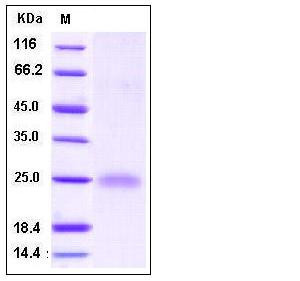Human Cystatin 7 / CST7 Protein
CMAP
- 100ug (NPP2066) Please inquiry
| Catalog Number | P10167-HCCH |
|---|---|
| Organism Species | Human |
| Host | Human Cells |
| Synonyms | CMAP |
| Molecular Weight | The recombinant human Cystatin F consists of 132 amino acids and predicts a molecular mass of 15.2 kDa. As a result of glycosylation, the apparent molecular mass of rhCystatin F is approximately 25 kDa in SDS-PAGE. |
| predicted N | Gly 20 |
| SDS-PAGE |  |
| Purity | > 95 % as determined by SDS-PAGE |
| Protein Construction | The mature form of the human Cystatin F (NP_003641.3) (Met 1-His 145) with five amino acids (DDDDK) at the C-terminus was expressed and purified. |
| Bio-activity | |
| Research Area | Immunology |Adaptive Immunity |T Cell |Non-CD of T cell |
| Formulation | Lyophilized from sterile 50mM Tris, 100mM NaCl, pH 8.0 1. Normally 5 % - 8 % trehalose and mannitol are added as protectants before lyophilization. Specific concentrations are included in the hardcopy of COA. |
| Background | The cystatin superfamily members are important natural cysteine protease inhibitors present in a wide variety of organisms and are divided into three classes. Cystatin F, also known as leukocystatin and CMAP (Cystatin-like Metastasis-Associated Protein), is a type 2 cystatin and its expression is limited to hematopoietic cells, with the highest expression levels being observed in monocytes, dendritic cells, and certain types of T-cells. Furthermore, cystatin F mRNA becomes up-regulated during dendritic cell maturation, and thus suggests a specific role of cystatin F in immune regulation. Cystatin F is produced as a dimer, an inactive cathepsin inhibitor which is activated by chemical reduction. In addition, Cystatin F and its homologues have been observed expressing in various human cancer cell lines established from malignant tumors, and thus indicates a new diagnosis and prevention approach of certain human carcinomas metastasis. |
| Reference |
